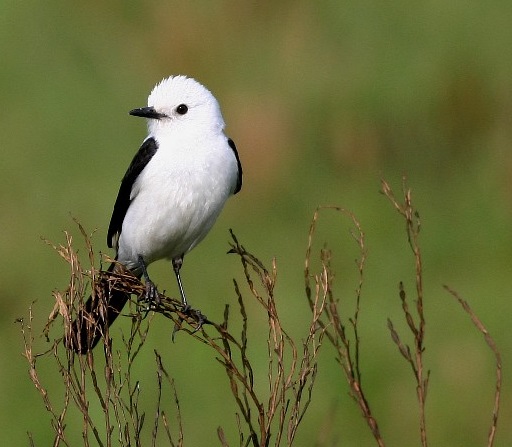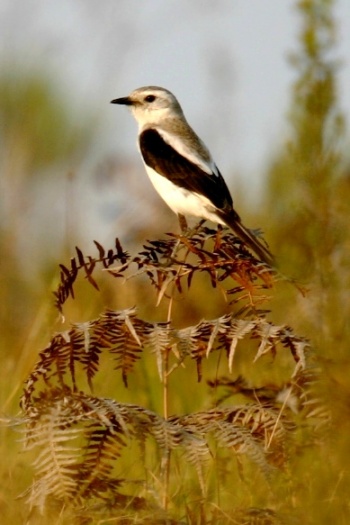m (→References) |
|||
| (17 intermediate revisions by 5 users not shown) | |||
| Line 1: | Line 1: | ||
| − | + | [[Image:Black-and-white_Monjita_male_by_Jamfaraco.jpg|thumb|550px|right|Male<br />Photo by {{user|Jamfaraco|Jamfaraco}}<br />Lages/SC, [[Brazil]], October 2006]] | |
| − | [[Image: | + | ;[[: Category:Xolmis|Xolmis]] dominicanus |
| − | + | ''Heteroxolmis dominicana'' | |
| − | |||
| − | |||
| − | |||
==Identification== | ==Identification== | ||
| − | + | *20.5 cm.<br /> | |
| − | == | + | ''' Male''' |
| − | + | *White body | |
| + | *Black wings and tail | ||
| + | *White wing-tips particularly noticeable in flight<br /> | ||
| + | '''Female''': similar | ||
| + | *Crown, back of neck and back are a brownish-grey | ||
| + | ==Distribution== | ||
| + | South-eastern [[Brazil]] (Paraná) to [[Paraguay]], [[Uruguay]] and north-east [[Argentina]] | ||
| + | ==Taxonomy== | ||
| + | This is a [[Dictionary_M-O#M|monotypic]] species<sup>[[#References|[1]]]</sup>.<br /> | ||
| + | |||
| + | This species is placed in the genus ''[[: Category:Xolmis|Xolmis]]'' by some authors<sup>[[#References|[1]]][[#References|[2]]]</sup> and [[: Category:Heteroxolmis|''Heteroxolmis'']] by others<sup>[[#References|[3]]]</sup>. The second part of the scientific name has recently been changed, from ''dominicana'' to ''dominicanus'' but this is not yet accepted by most world lists. | ||
| + | |||
| + | ==Habitat== | ||
| + | [[Image:Black_and_White_Monjita.jpg|thumb|350px|right|Female <br />Photo by {{user|Jamfaraco|Jamfaraco}}<br />Lages/SC, [[Brazil]], September 2004]] | ||
| + | Open areas, fields and humid fields, dry lowland grassland, seasonally wet or flooded lowland grassland, arable land, and pastureland. | ||
| + | ==Behaviour== | ||
| + | Other species, such as [[Saffron-cowled Blackbird]] likes to be around this species, seemingly because it is good at detecting approaching dangers such as raptors. | ||
| + | ====Vocalisation==== | ||
| + | Mostly silent. Occasionally delivers soft calls. | ||
| + | ==References== | ||
| + | #{{Ref-Clements6thAug15}}#{{Ref-HM04}}#{{Ref-GillDonsker15V5.3}}#BirdLife International | ||
| + | #Krüger & Petry (2010). Ornitologia Tropical 21(2): 299-303 | ||
| + | {{ref}} | ||
| − | |||
==External Links== | ==External Links== | ||
| − | {{GSearch| | + | {{GSearch|Xolmis+dominican}} |
| − | [[Category:Birds]] | + | <br /> |
| + | {{Video|Black_and_white_Monjita}} | ||
| + | |||
| + | [[Category:Birds]][[Category:Xolmis]] [[Category:Videos]] | ||
Revision as of 20:54, 4 September 2015
- Xolmis dominicanus
Heteroxolmis dominicana
Identification
- 20.5 cm.
Male
- White body
- Black wings and tail
- White wing-tips particularly noticeable in flight
Female: similar
- Crown, back of neck and back are a brownish-grey
Distribution
South-eastern Brazil (Paraná) to Paraguay, Uruguay and north-east Argentina
Taxonomy
This is a monotypic species[1].
This species is placed in the genus Xolmis by some authors[1][2] and Heteroxolmis by others[3]. The second part of the scientific name has recently been changed, from dominicana to dominicanus but this is not yet accepted by most world lists.
Habitat
Open areas, fields and humid fields, dry lowland grassland, seasonally wet or flooded lowland grassland, arable land, and pastureland.
Behaviour
Other species, such as Saffron-cowled Blackbird likes to be around this species, seemingly because it is good at detecting approaching dangers such as raptors.
Vocalisation
Mostly silent. Occasionally delivers soft calls.
References
- Clements, J. F., T. S. Schulenberg, M. J. Iliff, D. Roberson, T. A. Fredericks, B. L. Sullivan, and C. L. Wood. 2015. The eBird/Clements checklist of birds of the world: v2015, with updates to August 2015. Downloaded from http://www.birds.cornell.edu/clementschecklist/download/
- Dickinson, EC, ed. 2014. The Howard and Moore Complete Checklist of the Birds of the World. 4th ed. Princeton: Princeton Univ. Press. ISBN 978-0956861122
- Gill, F and D Donsker (Eds). 2015. IOC World Bird Names (version 5.3). Available at http://www.worldbirdnames.org/.
- BirdLife International
- Krüger & Petry (2010). Ornitologia Tropical 21(2): 299-303
Recommended Citation
- BirdForum Opus contributors. (2024) Black-and-white Monjita. In: BirdForum, the forum for wild birds and birding. Retrieved 16 April 2024 from https://www.birdforum.net/opus/Black-and-white_Monjita
External Links





